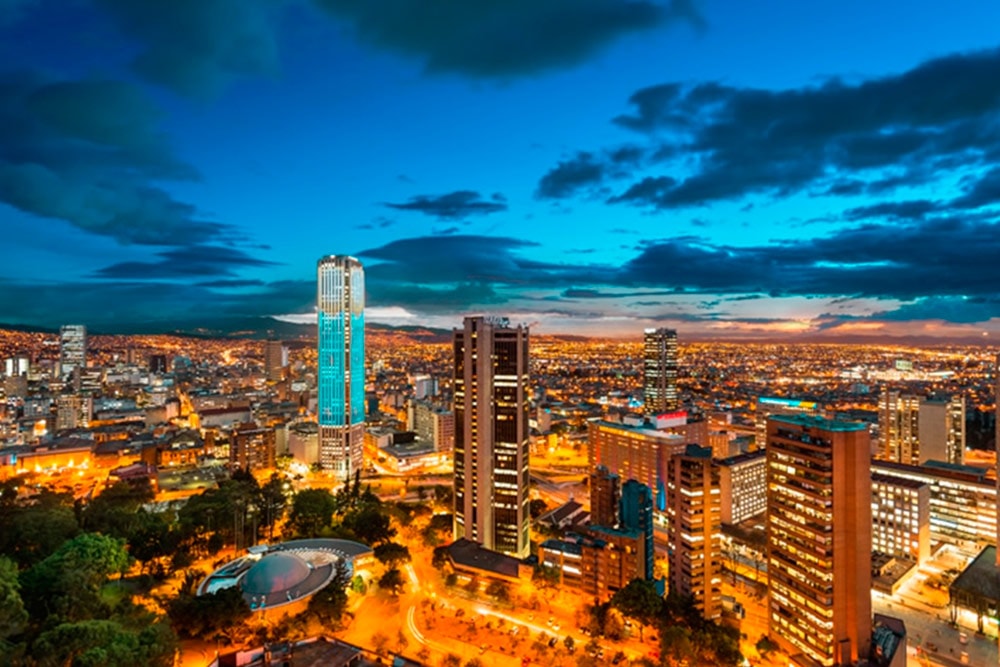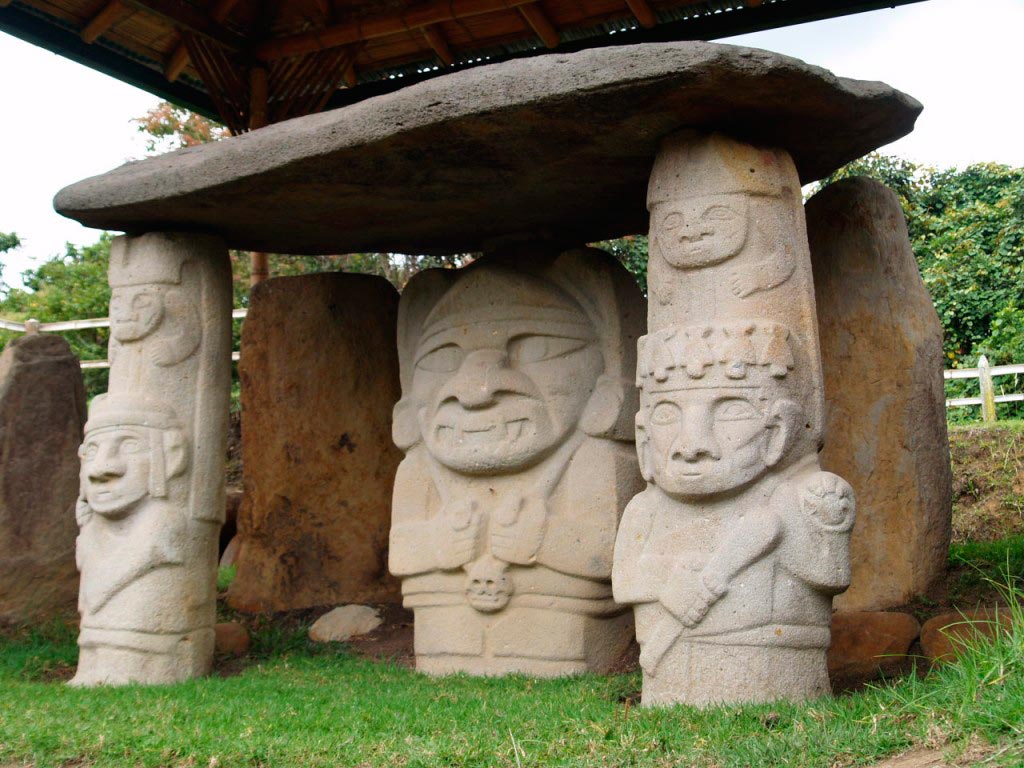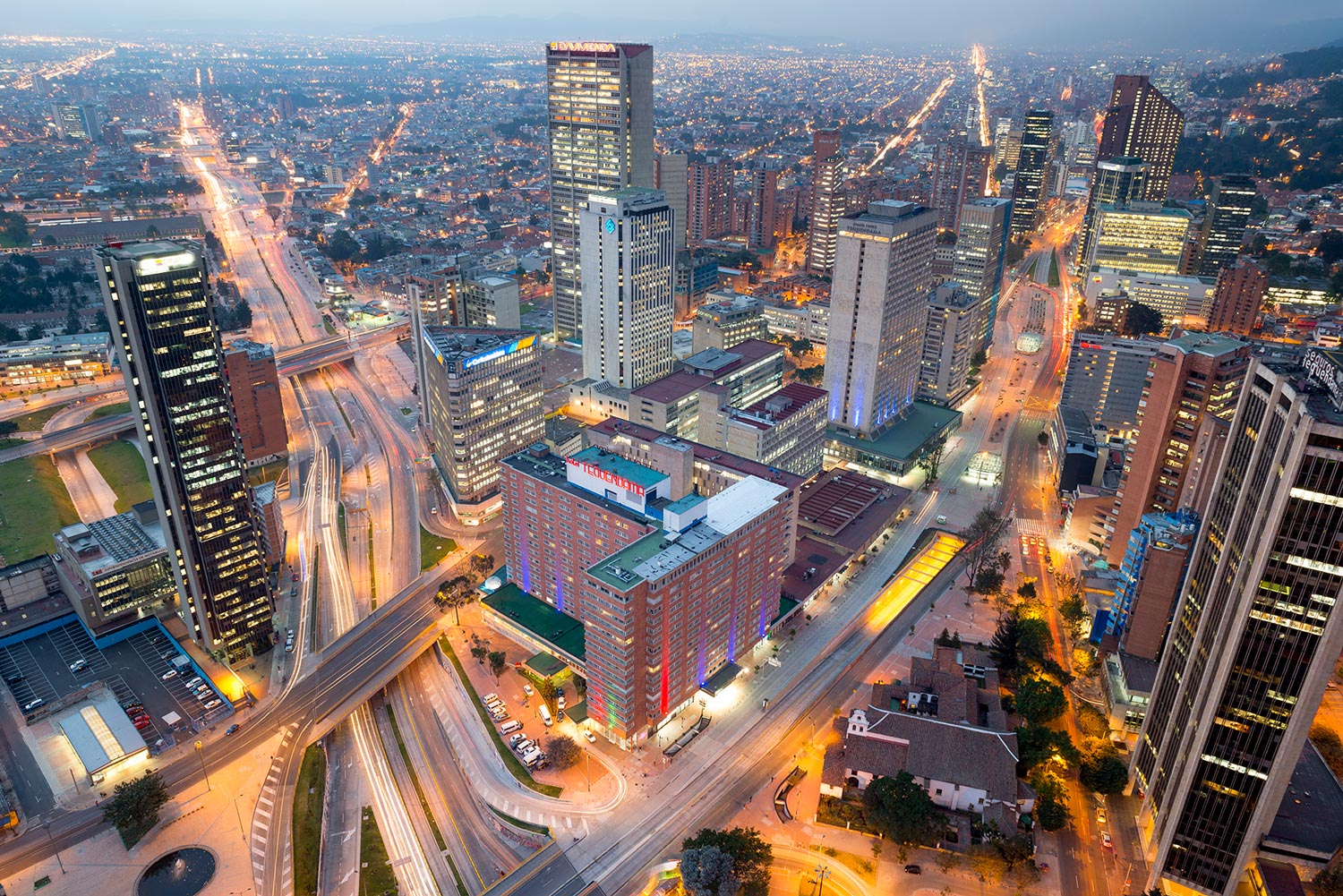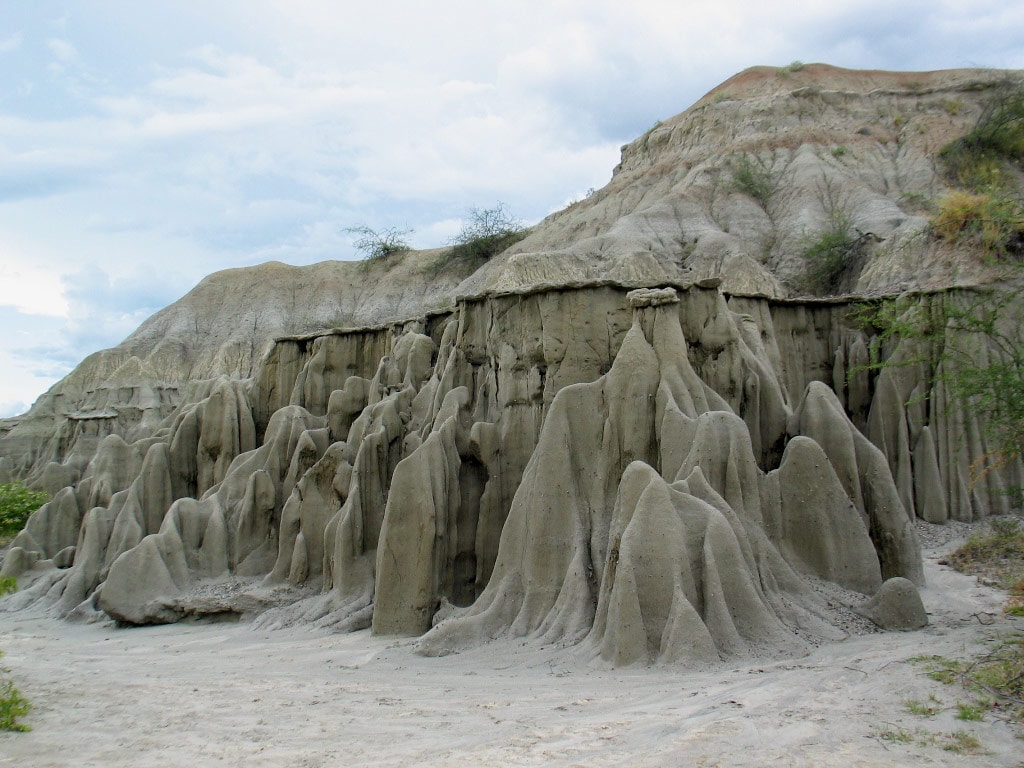Bogotá, Distrito Capital, abbreviated Bogotá, D.C (during the time of Spanish rule, and also from 1991 to 2000, called Santafé de Bogotá) is the capital and largest city of Colombia administered as the Capital District, although often thought of as part of Cundinamarca.Bogotá is a territorial entity of the first order, with the same administrative status as the departments of Colombia. It is the political, economic, administrative, industrial, artistic, cultural, and sports center of the country.
ITINERARY
- Day 1 | Arrival in Bogotá: Reception at the El Dorado International Airport in Bogota. Transfer to hotel. Dinner. Rest.
- Day 2 | Bogotá Tour: Breakfast. In the morning, we will start the city tour, by visiting the Cerro de Monserrate, located at 3152 meters above sea level, the Shrine of the Fallen Lord of Monserrate sheltering on its summit. It is a pilgrimage site surrounded by lush vegetation and where the best scenery of the savannah of Bogota is seen. We will visit the Quinta Bolívar Museum, a colonial style house in the town of Candelaria. Apart from its architectural interest, it is relevant from a historical point of view for having served as a residence in Bogota of Simon Bolivar, the liberator of five nations.
There we will observe the Manuelita Saenz rooms, ballroom, dining room, game room and the bedroom of the Liberator. We will visit El Museo del Oro(The Gold Museum), a place that brings together nearly 34,000 pieces of gold and 20,000 of stone, ceramics, textile objects and precious stones belonging to indigenous cultures of the Quimbaya, Calima, Tayrona, Sinu, Muisca, Tolima, Tumaco and Malagana tribes.
We can admire pieces in gold such as breastplates, masks, poporis, pendants, bracelets, necklaces, containers and thousands of figures of remarkable quality. Then we will see El Barrio la Candelaria (the Candelaria neighbourhood), the most recognized spot of the city because it is part around the historic center of Bogota, where the National Capital (El Capitolio Nacional), the Palace of Justice, the Cathedral of Bogota, and the Archbishop's Palace are found. We will end the tour in the Plaza Bolivar, the main square of the city of Bogota and Colombia, which is considered a major urban and architectural achievement of neoclassical beauty. After lunch we will visit the Museum of July 20 or vase house, and the museum of Independence. Dinner Show in typical Colombian restaurant. Rest. - Day 3 | Bogota - Zipaquira - Sabana de Bogota and Guatavita: Breakfast. We will drive on a beautiful highway which leads to the city of Zipaquira, where he will visit the Salt Cathedral of Zipaquira, an enclosure built inside a salt mine, and which is considered one of the most remarkable architectural and artistic achievements of Colombian architecture, even having been granted the title of architectural jewel of modernity. The importance of the Cathedral lies in its value as a cultural, religious and environmental heritage. A tour will be done of important places like the Plaza (where there’s a cross 4.20 meters high, called the Holy Axis), the Domo Salino, La Mina, El Museo de La Brine, built in a tank no longer in use.
It’s one of the most important places in the Salt Park. Here we will get to a pedagogical idea of the process of exploitation of salt. After lunch, we will travel to La Laguna de Guatavita, named for a circular lagoon (lake), whose meaning in the muisca language means: " End of the Tilling " or " Range Point ", where currently the belief says that the lagoon is full of gold due to the offerings of the muiscas which motivated many settlers, starting with the Spaniards, to try to empty the pond water through a cross section of the crater that contains it.
We will visit the town of cultural and handicraft center in the Guatavita region. At sunset, we will return to Bogota. At night, dinner and rest. - Day 4 | Bogota - Neiva- Villa Vieja (Old Village), Tatacoa Desert: After breakfast, we will drive to El Dorado International Airport to take our flight to the city of Neiva. Reception at the airport Benito Salas Neiva City. Transfer to hotel. Lunch and rest. In the afternoon, we will go to the municipality of Villa Vieja, considered a historical monument for humanity, because it is the oldest town in the department. Then we will visit the Paleontological Museum, founded in 1984, and housed in the Santa Barbara chapel. It is the oldest of the entire department, built by the Jesuits between 1606 and 1748. It was declared a national monument in 1982, showing around 667 original pieces, found in the desert of Tatacoa, We will understand step by step training and the origin of this spectacular ecosystem desert of Tatacoa, known as one of the most attractive natural settings in Colombia and the world, as it has been considered a dark skies place, which has 330 square kilometers of gray- and ocher-colored land. The Tatacoa Desert is a dry tropical forest which is a geographical landscape composed of geological formations in which varieties of fossils that tell the story of a life full of water millions of years ago. In the evening, we will visit the Astronomical Observatory since in this desert 88 constellations can be seen, and, in some privileged cases, meteor showers. At night, we will journey back to Neiva. Dinner. Rest.
- Day 5 | Neiva- Yaguará- Garzón: Breakfast. Departure from Neiva to Garzón. We visit the Municipality of Yaguará, passing by the Betania dam and taking a boat trip on the dam. Lunch at Yaguará. After lunch we will visit the Cueva del Tigre (Tiger Cave), a natural formation that allows you to explore the bowels of the earth and its history through underground passages that time ago were part of the seabed. We will find fossils of mollusks and crustaceans, observe the known stalactites, which are formations created by water seepage through the rock ceiling of the cave. Then we continue our journey to the municipality of Garzón, which borders on the El Quimbo Dam. Arrival and registration at the hotel. Dinner. Rest.
- Day 6 | Coffee Route | Gigante Pitalito- Zuluaga- Garzon Silvania: In the morning, we will visit the municipality of Garzon, known as the Diocesan Capital of Huila for being the first Catholic diocese in the region, highlighting its religious architecture. Then we will tour the coffee region of Huila, passing through the towns of Zuluaga and Silvania, known as the Place of Residence of the coffee pickers and finally we will reach a Coffee Growers Farm where we will stay. Dinner. Rest.
- Day 7 | Isnos- St. Augustine: Breakfast. In the morning we will see the processing of coffee, which is farmed and grown in the middle of the central and eastern branches of the Andes. It is characterized by presenting a balanced overall impression, with a sweet taste, acidity and medium / high body, fragrance and intense aroma, with fruity and caramelized sensations. We will finish with the collection process that the coffee growers do with this precious bean. We will eat lunch at the coffee farm. In the afternoon, we will head to southern Huila. In the course of the tour, we will see the Salto de Bordones, a waterfall highlighted in the stone wall of the Bordones river canyon, arriving quietly at the edge of the mountain, falling hard hundreds of meters down and losing itself among the vegetation and thick forests, which does not allow one to see the end of the waterfall. Then, we will pass by the Salto de Mortiño, a creek that runs between farms and forests that breaks the everyday landscape when we reach the edge of the mountains and falls into a canyon that the river has forged for years in a freefall of 170 m, before flowing into the Magdalena river.
Arriving at the town of Isnos, located in the bioregion of the Colombian Massif which houses much of biological and ecological diversity of the wealth of the planet, we will take the Altos de los Idols (Idols`Heights) tour, which is highlighted by its uniqueness and richness of human representations and animals, the dimensions and shape of the funerary structures and the presence of paint both in statuary and on the walls of tombs and templates. These monuments were built, because of their style, by the same society that inhabited San Augustine. Then we will tour the Alto de las Piedras (Alto Stones), which consist of a mountain that was transformed into a horseshoe, digging and removing earth from the center and filled laterally to form the arms of horseshoe, called table A and B, one of the best preserved funerary complexes and it has been the subject of ongoing archaeological research. Thanks to these characteristics, the High Idols Archaeological Park was included in the list of World Heritage by UNESCO in 1995. Finishing the tours we will go to the municipality of San Agustin. Dinner. Rest.. - Day 8 | St. Augustine: At the appointed time we will start the tour on horseback to find several figures carved on the high rocks, including one of anthropomorphic characteristics known as "The Goddess of Chaquira". Facing the abyss, her expression is integrated into the stunning scenery in an admirable way which evidences the mastery of the sculptors. And then we will use horses as transport to follow La Pelota (the Ball) route, a name given by the common people, as part of the hill where it is located is perfectly round like a ball. There the eagle statue devouring a snake is found as a beautiful painted shamanic representation with natural colors. Then we get to Magdalena Strait, a place where the most important river in Colombia can be seen with dimensions that do not exceed 3m wide and where lovers of extreme sports, go Rafting amidst majestic evening scenery. In the afternoon, we will visit the San Agustin Archaeological Park, considered the most important archaeological site in Colombia, where most of the area which was declared in 1995 by the Unesco World heritage is. Dinner Show. Rest.
- Day 9 | Colombian Massif: San Agustin-Quinchana- San Antonio: Breakfast. In a unique tour and experience breathing one of the purest air in the world, we will visit the Colombian Massif, water star (source)of Colombia. Through a mountain range of the Andes, we will travel in a Jeep from St. Augustine to reach the town of Quinchana. Then we will ride along the Magdalena River to get to San Antonio, where we will lodge with a local family. At sunset, enjoying the beautiful natural landscape, we will have dinner. Rest.
- Day 10 | Colombian Massif | San Antonio Village Laoyola: Breakfast. We will leave on horseback towards the Paramo de Las Papas, a spectacular journey through forests and rocky ravines along the path of the Magdalena River, reaching the Mirador de la Laguna de Magdalena, where we will observe the birth of the Magdalena River. We will hike to another viewpoint over the Laguna de Santiago (Santiago Lake) before descending to the village of Laoyola where where we will lodge on a farm with a local family. Dinner. Rest.
- Day 11 | Colombian Massif | Pueblo of San Agustin Valencia Laoyola: Breakfast. On a tour on horseback, we will travel to the town of Valencia where we will travel to San Agustin. Through the tour we will visit small towns where we will have our lunch. At the end of the day we will reach the city of St. Augustine. Dinner and rest.
- Day 12 | San Augustine Pitalito - Bogotá: Departure to the “El Contador” (The Counter) Airport of the municipality of Pitalito to take the flight to the city of Bogota.
- Day 13 | Bogotá: Lunch. Farewell dinner.
INFO
Name: Bogotá
Title: Colombia's capital
Gentile: Bogotanos
Surface: 1.587 km²
Population: 6,763 millions Inhabitants
Density: 0,01 hab/km²

WRITE TO US AND WE'LL BE IN CONTACT AS SOON
SITEMAP
INFORMATION
Phone:
(57) (8) 8760080
Email:
info@colombiaiscolombia.com
Great Britain - Colombia
Registro No. 44480





